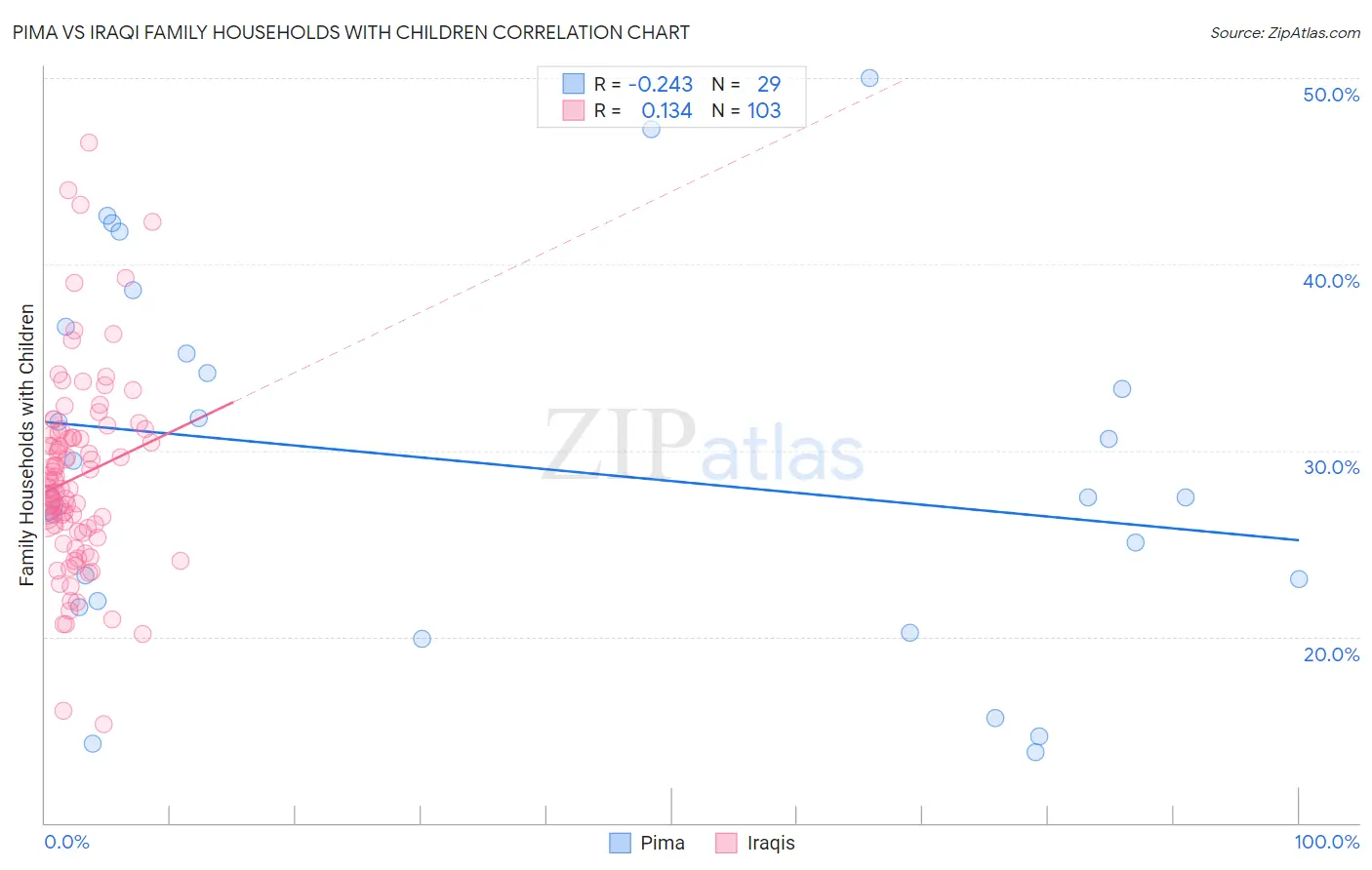Pima vs Iraqi Family Households with Children
COMPARE
Pima
Iraqi
Family Households with Children
Family Households with Children Comparison
Pima
Iraqis
27.1%
FAMILY HOUSEHOLDS WITH CHILDREN
9.2/ 100
METRIC RATING
223rd/ 347
METRIC RANK
28.5%
FAMILY HOUSEHOLDS WITH CHILDREN
99.9/ 100
METRIC RATING
73rd/ 347
METRIC RANK
Pima vs Iraqi Family Households with Children Correlation Chart
The statistical analysis conducted on geographies consisting of 61,534,200 people shows a weak negative correlation between the proportion of Pima and percentage of family households with children in the United States with a correlation coefficient (R) of -0.243 and weighted average of 27.1%. Similarly, the statistical analysis conducted on geographies consisting of 170,533,912 people shows a poor positive correlation between the proportion of Iraqis and percentage of family households with children in the United States with a correlation coefficient (R) of 0.134 and weighted average of 28.5%, a difference of 5.1%.

Family Households with Children Correlation Summary
| Measurement | Pima | Iraqi |
| Minimum | 13.8% | 15.3% |
| Maximum | 50.0% | 46.5% |
| Range | 36.2% | 31.3% |
| Mean | 29.2% | 28.5% |
| Median | 27.5% | 27.9% |
| Interquartile 25% (IQ1) | 21.8% | 25.6% |
| Interquartile 75% (IQ3) | 35.9% | 30.8% |
| Interquartile Range (IQR) | 14.2% | 5.2% |
| Standard Deviation (Sample) | 9.9% | 5.2% |
| Standard Deviation (Population) | 9.7% | 5.2% |
Similar Demographics by Family Households with Children
Demographics Similar to Pima by Family Households with Children
In terms of family households with children, the demographic groups most similar to Pima are Paraguayan (27.1%, a difference of 0.010%), New Zealander (27.1%, a difference of 0.030%), German (27.1%, a difference of 0.030%), Austrian (27.1%, a difference of 0.050%), and Immigrants from Japan (27.1%, a difference of 0.090%).
| Demographics | Rating | Rank | Family Households with Children |
| Cubans | 12.2 /100 | #216 | Poor 27.1% |
| U.S. Virgin Islanders | 12.1 /100 | #217 | Poor 27.1% |
| Greeks | 11.4 /100 | #218 | Poor 27.1% |
| Immigrants | Japan | 10.7 /100 | #219 | Poor 27.1% |
| Austrians | 9.9 /100 | #220 | Tragic 27.1% |
| New Zealanders | 9.6 /100 | #221 | Tragic 27.1% |
| Paraguayans | 9.4 /100 | #222 | Tragic 27.1% |
| Pima | 9.2 /100 | #223 | Tragic 27.1% |
| Germans | 8.7 /100 | #224 | Tragic 27.1% |
| Canadians | 7.5 /100 | #225 | Tragic 27.1% |
| Czechoslovakians | 6.6 /100 | #226 | Tragic 27.0% |
| Tsimshian | 6.6 /100 | #227 | Tragic 27.0% |
| Scottish | 6.5 /100 | #228 | Tragic 27.0% |
| Immigrants | Caribbean | 6.3 /100 | #229 | Tragic 27.0% |
| Bulgarians | 5.8 /100 | #230 | Tragic 27.0% |
Demographics Similar to Iraqis by Family Households with Children
In terms of family households with children, the demographic groups most similar to Iraqis are Laotian (28.5%, a difference of 0.010%), Immigrants from Indonesia (28.5%, a difference of 0.030%), Burmese (28.5%, a difference of 0.040%), Immigrants from Honduras (28.5%, a difference of 0.050%), and Immigrants from Korea (28.5%, a difference of 0.11%).
| Demographics | Rating | Rank | Family Households with Children |
| Immigrants | Egypt | 99.9 /100 | #66 | Exceptional 28.5% |
| Ghanaians | 99.9 /100 | #67 | Exceptional 28.5% |
| Houma | 99.9 /100 | #68 | Exceptional 28.5% |
| Immigrants | Korea | 99.9 /100 | #69 | Exceptional 28.5% |
| Immigrants | Honduras | 99.9 /100 | #70 | Exceptional 28.5% |
| Burmese | 99.9 /100 | #71 | Exceptional 28.5% |
| Immigrants | Indonesia | 99.9 /100 | #72 | Exceptional 28.5% |
| Iraqis | 99.9 /100 | #73 | Exceptional 28.5% |
| Laotians | 99.9 /100 | #74 | Exceptional 28.5% |
| Immigrants | Jordan | 99.9 /100 | #75 | Exceptional 28.4% |
| Immigrants | Sri Lanka | 99.9 /100 | #76 | Exceptional 28.4% |
| Nigerians | 99.8 /100 | #77 | Exceptional 28.4% |
| Immigrants | Nepal | 99.8 /100 | #78 | Exceptional 28.4% |
| Immigrants | Iraq | 99.8 /100 | #79 | Exceptional 28.4% |
| Natives/Alaskans | 99.8 /100 | #80 | Exceptional 28.4% |